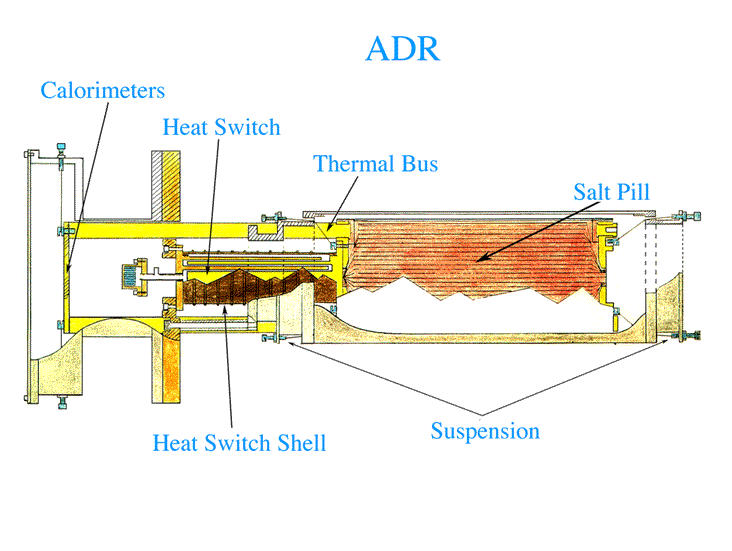Links
XRS Adiabatic Demagnetization Refrigerator (ADR) Cutaway Drawing
 D
D
ADR Primer explains the functions of the basic ADR components.
Here is a list of all the items labelled in this cutaway drawing, clockwise from upper left.
- Calorimeters
- Calorimeters are sensors which measure heat input. This ADR was designed to cool calorimeters for the X-Ray Spectrometer (XRS) instrument. These calorimeters measure the energy of x-ray photons by measuring the heat energy deposited when the photons are absorbed. The instrument will be used to measure x-rays coming from distant astronomical objects.
- Heat Switch
- The heat switch is used to allow heat to be dumped periodically to the helium bath (not shown.) The main components are: external shell (the brown cutaway part); getter chamber and connecting tube (off the left end); and the interleaved copper endpieces (the yellowish, reddish pieces that almost touch.)
- Thermal Bus
- The thermal busses (shown here in yellow) are copper rods that connect the calorimeters (which need to be cooled) with the salt pill (where the cooling action takes place.)
- Salt Pill
- The salt pill is where the cooling action takes place. The pill (actually a cylinder) is made of ferric ammonium alum (FAA), also called ferric ammonium sulfate. FAA was chosen to give good cooling power in the temperature range where this ADR wil operate. (Other ADR's use other materials.) When in use, the salt pill end of the ADR is slid into a superconducting magnet. Changing the applied magnetic field causes the salt pill to cool or heat. See ADR Primer for a description of the cycle. The horizontal lines running through the salt pill represent the wires that provide good thermal contact from the salt pill material to the heat switch and thermal busses.
- Suspension
- The outer structure of the ADR consists of metal rings and tubes, which allow the ADR to fit securely within the superconducting magnet. (The magnet is not shown in this drawing.) The salt pill is suspended within this rigid outer structure by means of Kevlar cords. (Kevlar is a DuPont trademark.) Kevlar is strong enough to hold the salt pill in place during the stress of launch, but has low thermal conductivity so that not much heat leaks into the salt pill through the suspension. The ends of the Kevlar lines are attached to bolts (shown in blue.) By turning the bolts, technicians can tighten or loosen the cords.
- Heat Switch Shell
- The brown part with the cutaway upper edge is the shell of the heat switch. The shell is a cylinder. It is made of Vespel, a polyimide material, which provides high strength with low thermal conductivity. (Vespel is a DuPont trademark.) Not shown in this drawing is a layer of titanium foil on the outside of the Vespel, to block room temperature permeation of helium from the heat switch.
Links
| |
 |
Curator:
Mark O. Kimball
NASA Official: Eric A. Silk
Last Updated: 09/11/2014
|
|

|


 Cryogenics & Fluids Home Page
Cryogenics & Fluids Home Page